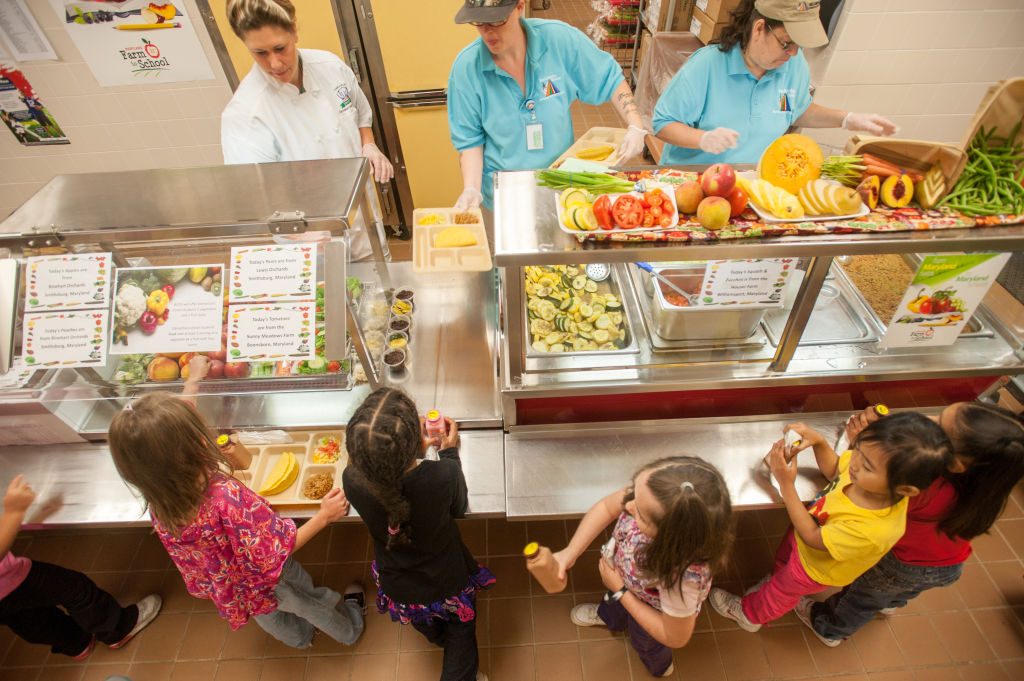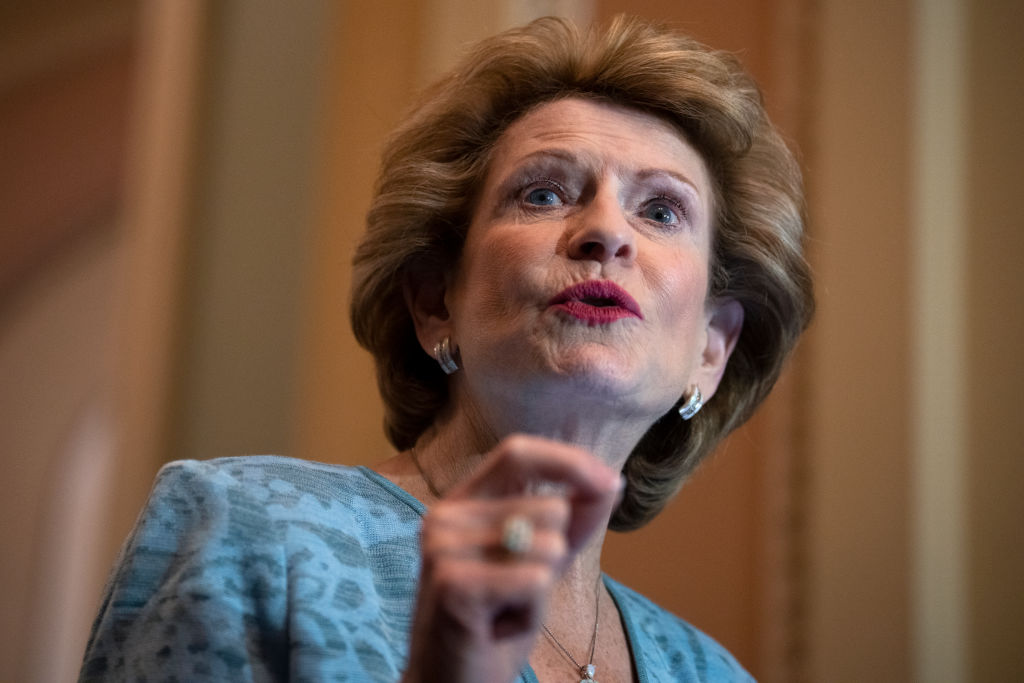
Suzanne Morales, the director of nutrition services for the 30-plus schools in California’s Placentia-Yorba Linda Unified School District, usually has to abide by strict conditions when feeding her district’s 24,000 students. Her schools must offer legumes, dark green vegetables, or red or orange vegetables daily, on a rotating basis, and all grain products must be at least 51% whole grain. Meals cannot contain added trans-fat, no more than 10% of calories can come from saturated fat, and every school lunch must offer one cup of fat-free or 1% milk.
Failure to meet these—or any other myriad National School Lunch Program (NSLP) stipulations—typically means that a district does not receive federal reimbursement for the meals they’ve provided. But two years ago, that system changed. In March 2020, when COVID-19 began spreading in the U.S., plunging tens of million families into economic uncertainty, the U.S. Department of Agriculture, with the help of additional Congressional funding, began issuing a handful of waivers that temporarily provided schools a workaround to some of the NSLP’s strict criteria, increased reimbursement rates, and allowed all children, regardless of their parents’ income levels, to access school meals.
The waivers were a huge success. Republicans and Democrats championed them, schools embraced the new flexibility, and billions of meals were provided to tens of millions of hungry kids. But, when the omnibus package that funds the government for Fiscal Year 2022 was introduced last month, an extension of the funding for school meal waivers wasn’t part of it. Instead, schools faced a looming deadline: the waivers are set to expire June 30.
The timing is bad. While the immediate public health threat of COVID-19 has passed, schools are now grappling with a 40-year inflationary high and unprecedented supply chain shortages on items including milk, vegetables and proteins, which often prevent them from meeting the pre-pandemic NSLP stipulations. School administrators, including Morales, are panicking. Child advocates are warning that children will go hungry. And lawmakers on Capitol Hill are pointing fingers at one another. Democrats blame Republicans for blocking an attempt to add the waiver extension into the omnibus legislation as an amendment, and Republicans blame the Biden Administration for failing to include the waiver extensions in its $22 billion COVID-19 supplemental budget request.
Now, a handful of Senators have introduced a bipartisan bill to extend the waivers through the 2023 school year—but its future is uncertain. Supporters need sixty votes to pass the measure, which is expected to cost $11 billion. While Democrats, including centrist Senators Kyrsten Sinema and Joe Manchin are on board, only two Republicans have signed on.
The stakes are high. If the bipartisan bill is not enacted, schools will have fewer funds to prepare meals under stricter nutritional guidelines and hundreds of thousands of school children in America won’t have access to the meals they’ve now relied on for years.
“All we want to do is feed kids,” Morales says.
Schools are struggling with labor shortages and rising costs
Even with the waivers in place, school lunch program operators say it’s increasingly difficult to make ends meet. Morales’ cost of paper goods, like napkins, has surged upwards of 60% since 2019; while her food costs are up 40%. The increased federal reimbursement rate, while crucial, offered her no more than a 30% boost, “which doesn’t match the increases on your costs,” she says.
Teresa Brown, Administrator of Ancillary Services for St. Charles Parish Public Schools in Luling, La., says retaining employees amid a nationwide labor shortage is an additional concern. Her district, which is still reeling from both the pandemic and the category-four Hurricane Ida that destroyed homes and businesses in Fall 2021, can’t compete with rising wages, leaving her short on staff. That shortfall makes providing meals more costly, she says, since it forces schools to use prepackaged meals, which are more expensive, but less labor intensive “than an item that we may cook from scratch.” Brown estimates it costs her schools “well over” $4 to provide a meal now, compared to less than $3 before the pandemic.
Under the pandemic-era waivers, federal reimbursement rates for school lunches increased from roughly $0.30 to $3.48 per meal, depending on geography and student’s income level, to around $3.66 per lunch. That’s a “wonderful” increase, Brown says, but it’s not enough. A recent survey by the national nonprofit School Nutrition Association found that even with the waivers, 48% of school meal programs anticipated a net loss for the 2020-2021 school year, and only 32% within that group anticipated having sufficient reserves to cover that loss.
Diane Pratt-Heavner, director of media relations of the School Nutrition Association, says that if the waivers are allowed to expire entirely, it will be financially devastating to schools. “Losing the waivers would be a double hit financially,” says Pratt-Heavner. “Not only would they lose that higher reimbursement rate, but they would see their meal participation decline, because the meals are no longer free for all students. And the fewer meals you serve, the higher per-meal costs.”
Schools are currently in the process of signing contracts for food staples and setting their school meal prices for next school year. Unless the waivers are extended soon, schools will have to offset the loss of the waivers and the record-breaking food costs by increasing their prices. Without the waivers, more students will once again be on the hook for buying meals at school. “We’re really getting to a crisis point,” says Pratt-Heavner. “Not only are you going to have families to suddenly have to pay for their meals, but they’re going to be paying more.”
The bipartisan effort to keep kids fed
Enter Senate Agriculture Chair Debbie Stabenow and Sen. Lisa Murkowski. On March 31, Stabenow, a Michigan Democrat, and Murkowski, an Alaska Republican, introduced a bill to extend the USDA school meal flexibilities from through September 30, 2023 in order to help schools transition back to normal meal guidelines and reimbursement rates under the USDA school meal programs.

“Following the widespread disruptions caused by COVID, life is beginning to feel more ‘normal’ for some. However, many Alaskans are still working to overcome the economic fallout from the pandemic and many schools continue to struggle with supply shortages and higher prices,” Murkowski said in a statement at the time of the bill’s introduction. “That’s why I’m glad to join Senator Stabenow and my Senate colleagues in a push to allow USDA to extend vital support for school nutrition programs and preventing barriers that may prevent students from receiving a healthy meal.”
Stabenow and Murkowski need to amass 60 total Senate supporters to pass the Senate’s filibuster threshold. “We have 50 members that are supporting extending these critically important flexibilities to feed children both in the summer as well as the school year,” Stabenow tells TIME.
So far, only Sen. Susan Collins, a Maine Republican, has joined Murkowski in supporting the bill on the GOP side. “We need eight more Republicans to join us and we can get this done,” Stabenow adds.
In the absence of enough Republican support, schools will struggle to abide by pre-pandemic criteria. Last summer, as Morales was serving 37,000 free meals—an 185% increase over summer 2019 levels—she couldn’t source a dark green vegetable to meet federal nutritional guidelines due to supply chain disruptions and inflation. Because of the flexibilities of the waivers, she was able to sub in carrots and still get federal reimbursement, allowing her to keep the meal program solvent. When these waivers expire, that sort of substitution will no longer be an option, and she’ll have lower reimbursement rates to come up with a solution that meets the guidelines.
“Really this is a situation of kids versus red tape,” says Stabenow. “If we don’t get these flexibilities so children can have the healthy food that they need to be successful, we’re going to basically go back to a situation where we have a whole lot of red tape and a whole lot of hungry children.”
More Must-Reads from TIME
- Cybersecurity Experts Are Sounding the Alarm on DOGE
- Meet the 2025 Women of the Year
- The Harsh Truth About Disability Inclusion
- Why Do More Young Adults Have Cancer?
- Colman Domingo Leads With Radical Love
- How to Get Better at Doing Things Alone
- Michelle Zauner Stares Down the Darkness
Write to Abby Vesoulis at abby.vesoulis@time.com